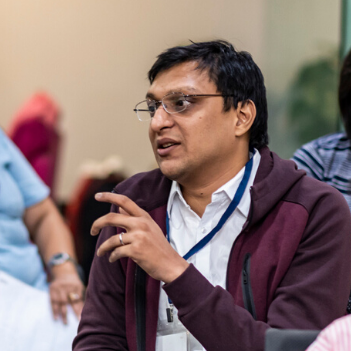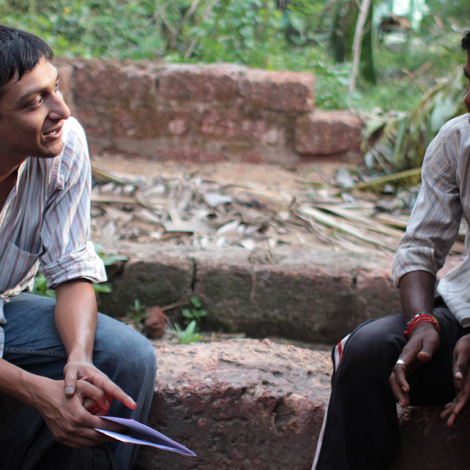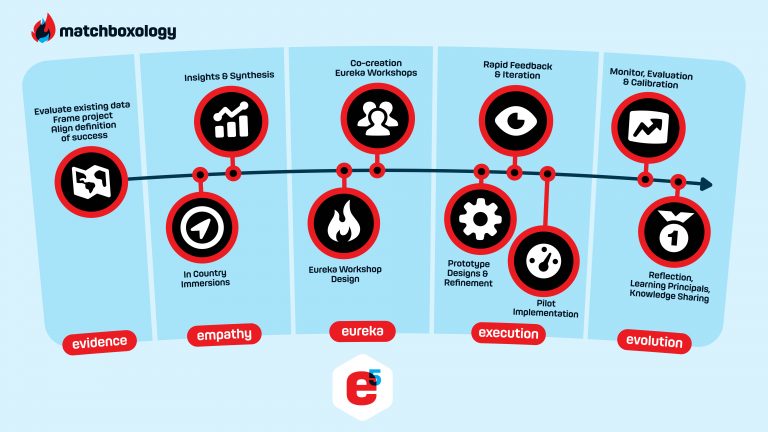Human-centered design is a maturing movement with real-world evidence to back its theories. Its successes have been so conclusive that the broader design community worldwide has adopted many human-centered practices, forcing a shift in the designer’s role. Two stories from one designer’s career illustrate the work and evolving job description of the human-centered designer in action.
 Design has ceased to be just design at this point in Akshay Roongta’s career. For more than a decade, the design consultant and social entrepreneur has taken an increasingly expansive view of the designer’s role. The designer does not just design, he says. Rather, the designer’s work envelopes business models, services, and considerations such as the ongoing maintenance of designed products. The theme to which Akshay returns over and over is the necessity of understanding people. For example, designers working in technology for good need a much broader view of who the stakeholder is, he says. When aid organizations and governments are involved, the person who uses a product is not always the same person who buys it. Designers, he says, need to go back to the people. And keep going back to all of the people who have a hand in the use, sale, maintenance and success of a product.
Design has ceased to be just design at this point in Akshay Roongta’s career. For more than a decade, the design consultant and social entrepreneur has taken an increasingly expansive view of the designer’s role. The designer does not just design, he says. Rather, the designer’s work envelopes business models, services, and considerations such as the ongoing maintenance of designed products. The theme to which Akshay returns over and over is the necessity of understanding people. For example, designers working in technology for good need a much broader view of who the stakeholder is, he says. When aid organizations and governments are involved, the person who uses a product is not always the same person who buys it. Designers, he says, need to go back to the people. And keep going back to all of the people who have a hand in the use, sale, maintenance and success of a product.
That concept is at the heart of human-centered design. As the non-profit design studio IDEO.org describes it, human-centered design is a creative approach to problem solving that starts with people. The organization publishes The Field Guide to Human-Centered Design, which should be the starting point for anyone curious or serious about design for social good.
Much has been written on the principles of human-centered design, but its most basic element is in-person, hands-on research among real people. Nuance emerges during phases in the development of a product or idea. For example, designers must learn who to talk to, what are the right kinds of questions to ask, and they must return again and again to the people for input on new iterations of prototypes, repeatedly ensuring that everyone’s needs are understood.
The role of designers has been the design of artifacts. But how do you situate those artifacts within systems, within relationships, within services, and even beyond that, within policy in society?
“Historically, the role of designers has been the design of artifacts. But what was always interesting to me is how do you situate those artifacts within systems, within relationships, within services, and even beyond that, within policy in society,” Akshay says.
Akshay’s water-vending startup Amrutdhara was a finalist in the Indian leg of the American Society of Mechanical Engineers Innovation Showcase in 2013. His focus at the moment is his social enterprise Ooloi Labs (http://OoloiLabs.in), which is building the Open Knowledge Platform as a resource to help social organizations grow. In those enterprises and throughout his adult life, Akshay has engaged in human-centered design.
A critical assessment of digital tools
In practice, human-centered design goes back to the people. Not just once, but repeatedly. To see how it works, Akshay offers an example from consultation he provided for an organization that prepares youth who have dropped out of school for their first jobs.
“They’re not employable. They might not even understand the term ‘job market,’” Akshay says. The typical enrollees are unmarried women and girls approaching the traditional age of marriage in the part of India where the organization operates, 16-19 years old. They undergo a three-month training course, then receive support in their job hunt.
The problem was that the organization lost touch with many of the graduates within 3-6 months, right at the time when the new employees could use support in skills like negotiating raises and learning new tasks. Most students didn’t use email, and phone ownership was not always approved for unmarried women. And those who had phones changed their numbers often. The organization used social media to organize its alumni, and they were building a mobile app for job searches. They turned to Akshay for help with their digital tools.
You can’t simply take something that exists in one context and just plant it in this and say, ‘hey,’ you know, ‘good. This works.’ It needs to reflect what people’s real-life challenges look like.
From the start, Akshay did not accept the terms of the problems as the organization had described. Rather than improving the social media strategy and building the jobs app, Akshay began to talk to people. All of the people.
“We turned the lens not just on the users, but on our clients. So deeply that we realized they didn’t have people with the right skills to be able to run this program if they ever wanted to run it,” Akshay says.
Akshay and his team trained the organization’s field staff in new methods for supporting graduates of the program. The consultants also wrote job descriptions for personnel that the organization should hire.
The key was face-to-face communication with people.
“What became clear was that if you had a process that was focused on digital engagement through social media, you are going to miss out on one swathe of your learners who may take too long to access technology, if ever. You will never be able to connect with them in the long run,” Akshay says.
Akshay and his colleagues proposed a mentorship program. Alumni who had been employed for a few months would mentor new graduates, track their progress and offer guidance.
“That mentor is someone you can stay in touch with digitally, but it’s their job to connect with four or five people who otherwise don’t have access to that kind of technology,” Akshay says. “Bringing in a physical component to the piece became quite critical.”
Then the consultants applied the same tactic to the jobs app. The consultants tested the app among the job seekers and the job providers, and found a fundamental flaw. Employers weren’t likely to post their available positions on it.
One of the things we keep trying to express to people is it’s baby and bathwater. You’re going to throw it all out if you try to go entirely digital. That’s just not where we’re at, especially the people that you’re trying to help.
“The problem was that if you don’t have that interaction and understanding of the larger system, you may create a jobs posting site like Indeed. But that’s not how this system works,” Akshay says. “You can’t simply take something that exists in one context and just plant it in this and do it in the local language and say, ‘hey,’ you know, ‘good. This works.’ It needs to reflect what people’s real-life challenges look like. That comes from a deeper interaction, not just with the end user, but with the system that enables positive outcomes.”
The jobs available were rooted in the local context. They were sales positions at a locally owned store, door-to-door sales for a cellphone company and so on. Locally, there was no precedent for posting jobs on an app. The app wouldn’t work if employers didn’t use it. To Akshay, that meant people had to get involved. The organization had to send placement officers out to the potential employers to gather postings. The officers guided employers, showed them how to post, and curated the jobs available to transform the app into a tool that actually worked.
“The app doesn’t work if you don’t have the entire ecosystem to enable it. That’s one of the things that we keep coming to, especially. I work primarily with the not-for-profit sector and social enterprises, and one of the things we keep trying to express to people is it’s baby and bathwater. You’re going to throw it all out if you try to go entirely digital. That’s just not where we’re at, especially the people that you’re trying to help. It needs to be a more nuanced approach that may have some digital elements, but you also have to have a very strong physical ecosystem that supports all of that,” Akshay says.
The amazing experience of lean experimentation
Akshay’s second story that illustrates the role of the human-centered designer begins further back in time when he was social entrepreneur prototyping his idea for a water-vending kiosk. The bottled water business in India is well established, but Akshay and his partners wanted to reduce plastic bottle waste and offer bottle refills. That was a new idea in the country at the time. He proposed to design and install quality-guaranteed “water ATMs” in shops and public spaces. Akshay partnered with Minhaj Ameen to co-found Amrutdhara, based in Auroville, an international township in southern India.
Early in the design process, an adviser at a startup incubator said that the first question to answer is whether or not people will actually buy water refills.
“You’re essentially selling loose water on the streets. Not packaged water,” Akshay says. The future of his startup depended on the answer to that question. So, he and his partner conducted surveys of potential customers, and the results were positive. But the incubator was planning to offer seed money, and surveys weren’t good enough to place a bet of (USD) $2000.
How do you build a cheap, small version of your product or service, and test it with real people?
“You need to do some lean experimentation, [they said]. And that was an amazing experience for us,” Akshay says.
The idea is to build a mocked-up version of the real product and provide customers with a version of the real experience, even if some of the pieces are simulated while their prototypes are still on the workbench.
“We took clean drinking water, put it in canisters and set up stalls like lemonade stands on the street at bus stops,” Akshay says.
The whole process was bootstrapped. The mock-ups were unlicensed and technically illegal, though the designers did have the unofficial blessing of a city commissioner. The water kiosks lacked some of the automation and Internet-of-things connectivity that were planned for the finished products. But they were acceptably close to Akshay’s vision.
“We were there hawking water. And we learned so much in that process. To the point where we pivoted our entire model. Our initial model was to have stand-alone kiosks selling drinking water. But when we did these experiments, we realized that people needed to get the water where they were. They wouldn’t even cross the road to get water. My partner calls it the Starbucks effect. You can have a Starbucks on both sides of the road because people aren’t going to cross the road to get a cup of coffee.”
Their experiment revealed that they needed many, many more machines. And the machines needed to be smaller. “The whole system needed to be smaller,” Akshay says.
“That, to me, is the heart of human-centered design. I’ve become a massive advocate for lean experimentation,” Akshay says. “Especially when I speak to social entrepreneurs. They have this big idea, this huge vision, and they are trying to raise all this money to build the perfect product. My point to them is, how do you build a cheap, small version of your product or service, and test it with real people? When you’re actually selling the water on the street, somebody either buys the water or they don’t buy the water.”
Lean experimentation cuts through the pitfall of customer surveys by revealing how people actually behave, rather than how they say they would behave in a hypothetical situation. It also allows for a useful kind of survey that wouldn’t be possible without the mock-up. Akshay and his partner asked real customers why they bought the refills rather than bottled water, and they asked people who passed them by why they didn’t stop.
“That was even better for us. Then we were trying to understand what would have convinced them. And if they could have been convinced at all,” Akshay says. “It’s those sorts of processes that bring together this reality check, prototyping and engaging with real customers.”
The designer’s new role
The role of the designer, therefore, is changing in at least two ways, Akshay says.
One change is that human-centered designers no longer have to advocate for research among stakeholders. The principles underlying human-centered design have proven so effective that they are increasingly adopted in conventional design. As a result, design teams conduct more thorough customer discovery and assessment. The designer needs to ensure that research informs the design.
The role of the human-centered designer is to be a champion of the user in the process going forward, and to keep bringing those insights back.
“Sometimes you can say you went out in the field and spoke to people in the field, but did that actually influence the process? That’s the place where the role of the designer comes in. The role of the human-centered designer is to be a champion of the user in the process going forward, and to keep bringing those insights back,” Akshay says.
A second change in the designer’s role is an expansion of the job description. The job has expanded so much, in fact, that the designer doesn’t even have to be a designer, Akshay says.
“One of the things that is clear to me is that human-centered design shouldn’t be the [exclusive] domain of the trained designer. I think it’s our role now increasingly as a trained human-centered designer to facilitate spaces and processes for others to engage with that. A lot of hard work nowadays in involved in trying to train field staff and middle managers to actually use these tools to create prototypes, things like that. It’s not for trained designers only,” Akshay says.
Apparently, the movement that designers led to include more and more people in their work has progressed to its natural limit. This design movement is so inclusive that even its leaders no longer need to be trained designers.
Many of the values of human-centered design are reflected in the design principles of technology for global development. For information, take E4C’s introductory design course online. It is self-guided and free of charge.

